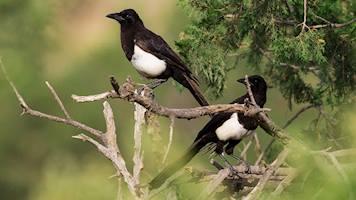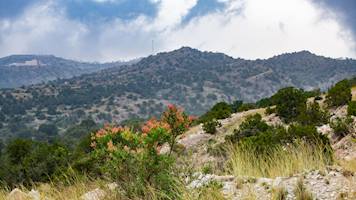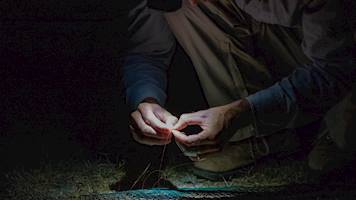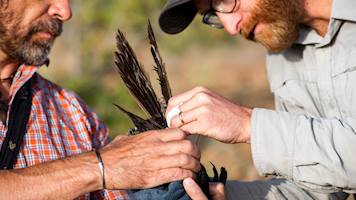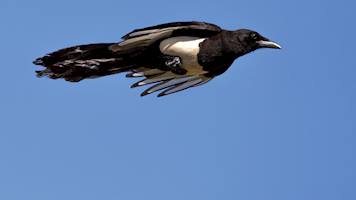Aramco is on mission is save Saudi Arabia's only endemic bird species, the highly-endangered Asir magpie, whose estimated numbers have dwindled to just 100 breeding pairs.
- Global offices
- Our businesses
- Production & refineries
- Joint ventures
- Research centers
Global directory
Global directory
Headquarters
Americas
Location
1200 Smith Street
Houston, TX 77002
Mailing Address
Aramco Americas
P.O. Box 4534
Houston, TX 77002
Asia
BEIJING
Aramco Far East (Beijing) Business Services Co., Ltd (ABS)
43/F, 45/F20-26, China World Tower 3,
No.1 Jianguomenwai Avenue,
Chaoyang District,
Beijing, China 100004
SHANGHAI
Aramco Far East (Beijing) Business Services Co., Ltd. Shanghai Branch
Room 16T60, 16/F – SWFC, 100 Century Avenue,
Pudong District,
Shanghai 200120, China
XIAMEN
Aramco Far East (Beijing) Business Services Co., Ltd. Xiamen Branch
15F, Paragon Center, No.1 Lianyue Road,
Siming District,
Xiamen 361012, Fujian, China
Aramco Asia India Pvt. Ltd.
2A-0801, 8th Floor, Two Horizon Center, DLF 5,
Sector 43, Gurugram 122002,
Haryana, India
Aramco Asia Japan K.K.
Marunouchi Building 26F2-4-1 Marunouchi, Chiyoda-ku,
Tokyo 100-6326, Japan
CONTACT US
Aramco Asia Korea Limited
45, Three IFC, 10 Gukjegeumyung-ro
Yeongdeungpo-gu, Seoul, 07326,
Korea
Aramco Overseas Malaysia Sdn Bhd
Level 32, Maxis Tower
Kuala Lumpur City Center
50088 Kuala Lumpur
Europe
Aramco Overseas Company
Via Lombardia 2/A, 1st floor, Building B
20068 – Peschiera Borromeo (MI)
Italy
Global Businesses
Gas production
Fadhili
Fadhili
The cutting edge Fadhili Gas Plant (FGP) is emblematic of Saudi Aramco’s broad impact on not only boosting gas supply to displace crude burning, but also driving economic growth, developing the Saudi workforce, spearheading technology deployment, and reducing CO2 emissions. FGP construction started in 2016 and was completed and put fully onstream in 2020.
With a total processing capacity of 2.5 BSCFD, FGP is the first plant in the region to have the capability of sweetening low BTU gas, then directly powering an independent power plant, yet able to switch to regular sales gas as needed. In addition, Fadhili is the first plant to treat nonassociated gas from both onshore and offshore fields.
FGP is also the first SA Gas plant to deploy the Sulfur Recovery Unit Tail Gas Treatment process to attain a sulfur recovery rate of 99.9%, helping to protect air quality, and reducing SO2 emissions by more than 18,000 Metric Tons per year as compared to the conventional Claus process.
The development of Fadhili added billions of dollars to the local economy through IKTVA. 46% of the project’s materials and services were sourced and manufactured in Saudi Arabia.
A unique feature of Fadhili is that its multiple downstream treated gas pipelines enhanced the connectivity, reliability, and responsiveness of Saudi Aramco’s Master Gas System (MGS), as those pipelines are connected to the northern and central sections of the MGS.
Hawiyah
Hawiyah
We are expanding the gas processing capacity of our Hawiyah gas plant by more than 1 BSCFD. The new gas processing facilities, expected to be on stream in 2022, are anticipated to raise total production capacity of the plant to approximately 3.6 BSCFD, making it one of the largest gas processing facilities in the world.
We are making improvements to sustain gas production from both the Haradh and Hawiyah fields for the next 20 years and boost production by an average of 1.2 BSCFD. The program includes installing gas compression facilities, liquid separation stations, and transmission lines to our Haradh and Hawiyah gas plants, along with expanding the existing gas gathering pipeline network.
Karan
Karan
Karan, was our first non-associated offshore gas field development. Discovered in 2006 in the thickest, extremely prolific and complex carbonate layers, the project was fast-tracked, taking only six years to go from discovery to production.
Non-associated gas fields do not have an associated oil column and, therefore, can be accessed without producing oil. The raw gas is transported through a 110-kilometer subsea pipeline to the Khursaniyah Gas Plant for processing.
Shaybah
Shaybah
The natural gas liquids (NGL) recovery plant at Shaybah was commissioned and began production in late 2015, with a second processing train starting up in 2016. The plant NGL production helps Saudi Aramco to meet increasing demand for petrochemical feedstock.
Designed to process as much as 2.4 BSCFD of associated gas and recover 275,000 bpd of ethane plus NGL, the Shaybah facility feeds these volumes of NGL via pipeline to Ju’aymah for further processing before being delivered as petrochemical feedstock to industrial cities.
Wasit
Wasit
Wasit, one of the largest gas plants we have ever built, was brought onstream in October 2015 and reached full operating capacity in mid-2016. Unlike our other gas plants, Wasit is designed to process solely nonassociated gas.
To feed Wasit, we brought gas production onstream from the big bore nonassociated gas wells in our offshore Arabiyah and Hasbah fields, situated approximately 150 km northeast of Jubail Industrial City in the Arabian Gulf. With the startup of production from these two fields, more than 40% of our nonassociated gas now comes from offshore fields.
Our continued success in increasing supplies of cleaner burning natural gas makes it possible for us to reduce emissions, enable new industries and release more crude oil for value-added refining or export.
Oil production & Refineries
Abqaiq
Abqaiq
As the company's largest oil processing facility and the largest crude oil stabilization plant in the world, Abqaiq plays a pivotal role in our day-to-day operations.
Abqaiq oil facilities receive sour crude oil from gas-oil separation plants (GOSPs), process it into sweet crude oil, and then transport it to Ras Tanura and Jubail on the east coast, Yanbu' on the west coast and to Bapco Refinery in Bahrain. The off gases from the spheroids and stabilizer columns that are part of the conversion process are then sent to Abqaiq natural gas liquids (NGL) facilities for further processing.
Abqaiq is the main oil processing center for Arabian Extra Light and Arabian Light crude oils.
Ghawar
Ghawar
The northern-most portion of the Ghawar field lies approximately 100 kilometers west of Dhahran. The field comprises six main areas (Fazran, Ain Dar, Shedgum, Uthaminyah, Hawiyah and Haradh) and extends southward over more than 200 kilometers as one long continuous anticline. It is approximately 36 kilometers across at its widest point.
We believe that the Ghawar field is the largest oil field in the world in terms of conventional proved reserves, totaling 58.32 billion barrels of oil equivalent as at 31 December 2018. It has accounted for more than half of the total cumulative crude oil production in the Kingdom.
The Ghawar field facilities and infrastructure remain a central component in our long-term strategic framework for optimizing both technical recovery of resources and the economic of resource management.
Haradh
Haradh
The Haradh area, located at the southern tip of the Ghawar oil field, was developed in three increments of 300,000 bpd of Arabian Light crude oil capacity.
Haradh III was also the first plant in the Southern Area of company operations to have completely automated well control and monitoring, allowing remote operations. The project benefited from successful integration of four technologies: multilateral, maximum reservoir contact (MRC) wells; Smart Well completions (using control valves for preventing premature water breakthrough); geosteering (for optimal placement of wells in the reservoir for maximum recovery); and the “intelligent field” concept, in which real-time sub-surface data transmissions enable continual monitoring of key reservoir indicators. The integrated use of these four technologies slashed unit well development costs three-fold.
Khurais
Khurais
The Khurais complex, which comprises of the Abu Jifan and Mazalij fields in addition to Khurais itself, is approximately 106 kilometers long and 18 kilometers across at its widest point.
Khursaniyah
Khursaniyah
The Khursaniyah program includes facilities to process and stabilize 500,000 bpd of Arabian Light crude oil blend from the Abu Hadriya, Fadhili and Khursaniyah fields, and a grassroots gas plant to process one billion scfd of associated gas.
Khursaniyah began producing oil in August 2008. The facility also has the capacity to inject 1.1 million bpd of non-potable water for reservoir pressure maintenance.
Manifa
Manifa
The UNESCO environmental responsibility award nominated Manifa crude oil development was designed to produce 900,000 bpd of Arabian Heavy crude oil, 90 million scfd of sour gas, and 65,000 bpd of hydrocarbon condensate.
By employing best-in-class technologies in infrastructure, drilling and production activities, the project consumed more than 80 million man hours without a lost time injury.
Prior to construction, extensive engineering and ecological assessments were conducted to ensure that the marine ecosystem would not be adversely affected by developing the field. As a direct result of these studies, Saudi Aramco constructed three kilometers of bridges to span the migration paths of various marine species, maintaining natural water flow and preserving natural marine nurseries.
Nuayyim
Nuayyim
Nuayyim crude oil increment added 100,000 bpd of Arabian Super Light crude oil and 90 million scfd of associated gas to our production capacity.
The project – the first in-Kingdom project of this scale with a project proposal completed entirely in Saudi Arabia – also included a gas-oil separation plant, 140 kilometers of 16” gas pipeline, and water supply facilities at Hawtah. Smokeless flaring has been used to significantly reduce emissions.
The field, which entered production in August 2009, is 250 kilometers south of Riyadh and about 50 kilometers northeast of our Hawtah crude oil facility, the first producing facility in the Central Region of Saudi Arabia.
Qatif
Qatif
Qatif Producing Plants Program consists of facilities to produce, process, and transport 500,000 bpd of blended Arabian Light crude oil from the Qatif field and 300,000 bpd of Arabian Medium crude oil from the offshore Abu Sa'fah field.
The Qatif facility was the first to produce Arabian Light crude oil by blending Arabian Extra Light, Light and Medium grades.
Safaniyah
Safaniyah
We believe that Safaniyah field is the world's largest conventional offshore oil field in terms of proved reserves. It is located approximately 260 kilometers north of Dhahran. Most of the field lies offshore in the Arabian Gulf. Within the Concession area, the Safaniyah field is approximately 50 kilometers long and 15 kilometers wide.
Shaybah
Shaybah
The Shaybah field, located in the Rub’ al-Khali or Empty Quarter, was discovered in 1968. Its remote location, local summer temperatures in excess of 50 degrees Celsius and sand dunes higher than 300 meters presented serious challenges. So for technical and economic reasons, development was held off until 20 years later. However, by the 1990s, advances in 3D seismic imaging technology, horizontal drilling and other technologies gave us the tools we needed to begin production.
The field is approximately 13 kilometers wide and 64 kilometers long. Due to the field's remoteness, its facilities include a dedicated NGL recovery unit, an airfield and accommodation for staff.
Our second 250,000 bpd expansion project at Shaybah came on-stream in 2016, raising its overall production capacity to 1 million bpd of Arabian Extra Light crude oil — double the facility’s original capacity.
Zuluf
Zuluf
The Zuluf field is located in the Arabian Gulf, approximately 240 kilometers north of Dhahran, in average water depth of 118 feet. The field has two main structures, Zuluf and Ribyan, and is of similar area to Safaniyah to the north.
Refinery
Jazan Refinery
Jazan Refinery
Aramco operates one of the world’s largest refining businesses, and its integrated petrochemical refinery complex at Jazan City for Primary and Downstream Industries is part of the Company’s vibrant downstream growth strategy.
In 2020, Aramco confirmed that it would proceed with the divestment of the Jazan Integrated Gasification and Combined Cycle Plant into a Joint Venture (JV) between Aramco, Air Products, ACWA Power, and Air Products Qudra, integrating the Air Separation Unit into the JV.
With the addition of our Jazan Refinery Complex, Aramco has five wholly owned refineries within the Kingdom, three of which were built specifically to supply transportation and utility fuels for the domestic marketplace. Aramco’s four domestic affiliated refineries within the Kingdom are highly competitive with other world-class facilities based on scale, configurations and product yields.
Joint ventures
Hyundai Oilbank
Hyundai Oilbank
Hyundai Oilbank is a refinery in South Korea, established in 1964. The Daesan Complex, where Hyundai Oilbank’s major facilities are located, is a fully integrated refining plant with a processing capacity of 650,000 barrels of crude oil per day. Aramco has a 17% equity interest in Hyundai Oilbank.
Idemitsu Kosan Co., Ltd
Idemitsu Kosan, one of leading refining and marketing companies in Japan, is a result of a merger between Idemitsu and Showa Shell Sekiyu. Its sales in Japan are primarily gasoline, diesel oil, kerosene and automotive lubricants. Idemitsu Kosan owns and operates more than 6,400 retail service stations, has equity stakes in six refineries, and a gross refining capacity of 945,000 bpd. Aramco owns a 7.7% equity interest in Idemitsu Kosan.
Motiva Enterprises
Motiva Enterprises, a fully owned affiliate of Saudi Aramco, operates the Port Arthur Refinery, the largest refinery in the U.S. at 635,000 bpd in Port Arthur, Texas. Motiva has acquired a 100% equity interest in Motiva Chemicals LLC (formerly Flint Hills), a chemical plant in Port Arthur, Texas.
Sinopec SenMei Petroleum Company Ltd.
Sinopec SenMei Petroleum Company Limited is a joint venture of Sinopec, ExxonMobil China Petroleum & Petrochemical Company Limited and Saudi Aramco Sino Company Limited. Sinopec SenMei, with headquarters in Fuzhou, is mainly engaged in the wholesale, retail, storage, throughput and transport of the processed oil, lubricant and other petroleum products, operation of convenience stores of service stations, car washing, lubricant replacement, restaurant and other auxiliary services.
Chemicals
Arlanxeo
Based in Maastricht, Netherlands, as a wholly-owned subsidiary of Saudi Aramco, ARLANXEO serves the development, production, marketing, sale and distribution of specialty chemicals and synthetic rubber products, principally for the high-volume global tire and automotive industries.
Rabigh Refining and Petrochemical Company (Petro Rabigh)
A joint venture between Saudi Aramco and Sumitomo Chemical. The products produced are used in such end products as plastics, detergents, lubricants, resins, coolants, anti-freeze, paint, carpets, rope, clothing, shampoo, auto interiors, epoxy glue, insulation, film, fibers, household appliances, packaging, candles, pipes and many other applications.
PRefChem
PRefChem venture is a strategic alliance between Saudi Aramco and Petronas, through equal ownership in two joint ventures, namely the Pengerang Refining Company Sdn. Bhd. (PRefChem Refining) and the Pengerang Petrochemical Company Sdn. Bhd. (PRefChem Petrochemical), collectively known as PRefChem.
Saudi Aramco Total Refining and Petrochemical company
The Saudi Aramco Total Refining and Petrochemical Co. (SATORP), a joint venture between Saudi Aramco and Total in Jubail, supports Saudi Aramco’s efforts to expand the value chain and achieve maximum value from the Kingdom’s resources. It processes heavy Arabian crude daily into low-sulfur gasoline, diesel and jets fuel that comply with the standards in the United States, Europe and Japan. It also produces paraxylene, benzene, sulfur and pure petroleum coke that fuels cement plants and electric power stations.
Yanbu Aramco Sinopec Refining Company
The Yanbu Aramco Sinopec Refining Company (YASREF) Ltd., a joint venture between Saudi Aramco and China Petrochemical Corporation (Sinopec), is a world-class, full-conversion refinery that covers about 5.2 million square meters in the Yanbu Industrial City, and is the key anchor project in Yanbu. YASREF uses 400,000 barrels per day (bpd) of Arabian heavy crude oil to produce premium transportation fuels, as well as high-value refined products for both international and domestic markets.
YASREF is a significant addition to the impressive downstream portfolio of Saudi Aramco, while building on and cementing the strategic partnership with Sinopec, Saudi Aramco’s largest crude oil partner and buyer. Both companies bring commercial and technical expertise to the joint venture to enhance trade of transportation fuels between a significant energy producer and its consumer.
In addition, YASREF represents a continuing step forward in the strategies of Saudi Aramco and Sinopec to drive growth further downstream to capture additional value along the hydrocarbon chain.
All centers
United Kingdom
Aberdeen, Scotland
Our Technology Office in Aberdeen focuses on drilling and production technologies. The European arm of Saudi Aramco Energy Ventures (SAEV) is located within the office, whose mission is to source and develop relationships with strategically significant and innovative energy technology companies.
China
Beijing
Our Beijing Research Center conducts research on chemical enhanced oil recovery and advanced seismic imaging technologies, including automated fault detection and improvements in data quality through super resolution.
The Center is also evaluating the expansion of research activities into the downstream sector in areas such as transportation efficiency, greenhouse gas management, advanced control and power systems, robotics, materials science, nanotechnology and advanced computing.
South Korea
Daejeon
Our CO2 Management Collaboration at the Korean Advanced Institute of Science and Technology (KAIST) in Daejeon, South Korea, is dedicated to addressing issues related to carbon management. The collaboration follows an interdisciplinary approach to innovative and cost-effective CO2 capture, storage, and conversion from fixed and mobile sources.
The Netherlands
Delft
The Delft University of Technology in the Netherlands is home to our technology office that focuses mainly on seismic processing and subsurface imaging to help us better understand the nature of our subsurface geology.
Russia
Moscow
Aramco Innovations Research Center
Leninskiye Gory 1 bldg 75-B
119234 Moscow
Russia
France
Paris
Our Aramco Fuel Research Center in Paris is located at IFP Energies nouvelles (IFPen). IFP Energies nouvelles is a public-sector research, innovation and training center active in the fields of energy, transport and the environment. Thanks to this strategic placement, we can capitalize on IFPen’s facilities and links to various European automakers to accelerate the innovation cycle of different fuel technologies.
Saudi Arabia
Dhahran
Our research areas at our Dhahran headquarters include the Research & Development Center (R&DC) and the EXPEC Advanced Research Center (EXPEC ARC).
EXPEC ARC develops specialized technologies necessary to achieve its upstream objectives of increasing discovery of oil resources and increasing reservoir recovery. An expansion of the EXPEC Advanced Research Center is currently underway, with new facilities to enable integrated research on sustainability technologies.
Our R&DC focuses on cutting-edge technologies that enhance operational reliability, efficiency and safety, as well as investigating clean fuels and the management of carbon release.
Thuwal
Our research center at the King Abdullah University of Science and Technology (KAUST) focuses on catalyst development, materials science, nanotechnology, robotics, solar energy materials and fuel technology. The strong capabilities provided in downstream areas are complemented by our FUELCOM collaboration with the KAUST Clean Combustion Research Center.
USA
Boston
Aramco Research Center-Boston supports development in the areas of computational modeling, advanced materials, and nanotechnology. The center works on collaborative research projects with the nearby Massachusetts Institute of Technology (MIT) faculty, with a focus on modeling, visualization, simulation, and advanced materials.
Our Aramco Research Centers in Detroit, Houston, and Boston have a collaboration with the MIT Energy Initiative (MITEI) to support research by two Low-Carbon Energy Centers designed to address climate change challenges. The centers bring together researchers from multiple disciplines at MIT to engage with companies, governmental agencies, and other stakeholders to further research and promote clean energy technologies to mitigate climate change.
Detroit
Our Aramco Research Center in Detroit focuses on competitive transportation solutions, improving the efficiency of current and future engines, reducing overall environmental impact, cost, and complexity of engine systems.
The Center can accommodate light-duty and heavy-duty fuels research programs and also offers full on-site integration and the demonstration of new vehicle technologies. Our Strategic Transportation Analysis Team, based in the Detroit Center, provides dynamic industry analysis relevant to our fuels research and development activities.
Houston
Aramco Research Center in Houston focuses on upstream technologies for conventional and unconventional resources to support discovery and recovery goals. Specific areas of research include advanced seismic imaging, unconventional productivity enhancement, smart fluids to improve well productivity, nano-based polymers, surfactants, cement technologies related to drilling operations, quantitative geology, and advanced downhole sensors. It is our largest center outside Saudi Arabia.

